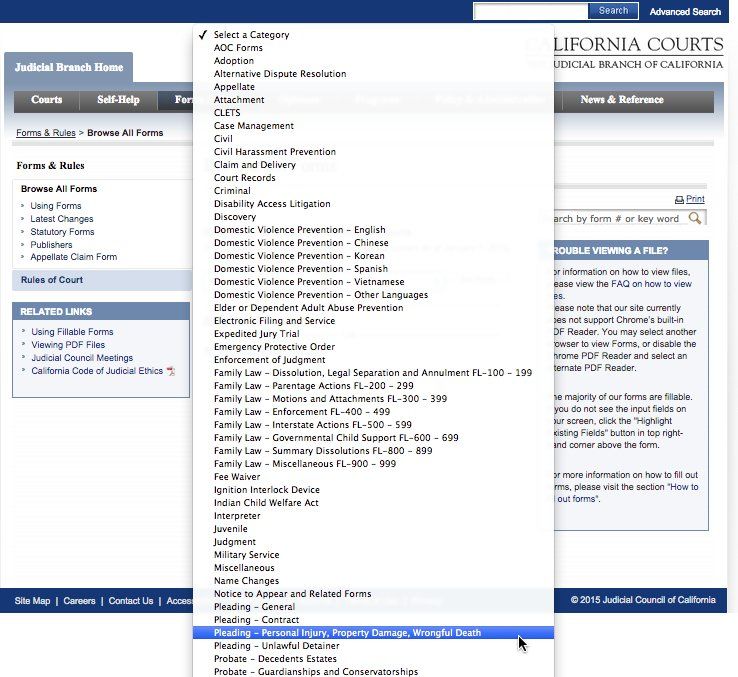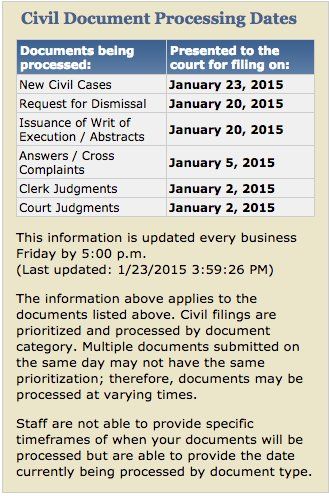GET YOUR FREE CONSULTATION
How to File a Personal Injury Lawsuit (Without a Lawyer)
Read the blog from Frank Penney Injury Lawyers in Roseville, CA below.
If you’ve been a victim of a car accident or have suffered another injury, you may be motivated to file a personal injury claim against someone or some organization. You may also be thinking about filing the claim yourself instead of using a lawyer.
If you’re considering filing a civil lawsuit yourself, this post will help you understand the basics of filing the lawsuit with the Sacramento court system.
How Long Do I Have to File a Lawsuit?
In the state of California, the statute of limitations is 2 years for a personal injury claim. This means that you, the Plaintiff, have 2 years to either settle your lawsuit or file a complaint for personal injury damages in court.
How Do I Know Where to File my Lawsuit?
You must file your lawsuit in the county in which the accident occurred. The police report that you hopefully have from your accident will tell you which county. If you don’t have a police report, look at the direct location of the accident to determine the county.
Do I Have to Use an Attorney to File a Lawsuit?
The short answer is no. But, as you will see below, the process, forms and expenses can be daunting. Often injured parties choose to use a
qualified personal injury attorney because they simply don’t have the time and expertise to navigate the complexities of the court system.
If I Don’t Use an Attorney, What Forms Do I Need?
If however, you wish to review the forms and fill them out on your own, they are available free of charge at the California Courts forms download page.
Once here, you would select the pull-down bar for Pleading – General, then select “see forms.” From here, you can look at forms either by number or name.
FORMS NEEDED FOR FILING A PERSONAL INJURY SUIT
The forms you will need for an accident with injury and/or property damage are the following:
- Summons, Form #SUM-10
- Civil Case Cover Sheet, Form #CM-010
- Complaint – Personal Injury, Property Damage, Wrongful Death, Form #PLD-PI-001
- Cause of Action – Motor Vehicle, Form # PLD-PI-001(1)
- Cause of Action – General Negligence, Form #PLD-PI-001(2)
- Alternative Dispute Resolution Information Package must be served in ALL cases
- Stipulation and Order to Mediation (CV-E-179) must be served on any Unlimited Civil Case
If you decide NOT to use Judicial Council forms, you have the option to submit your complaint on pleading paper following the rules outlined in California Rules of Court, Rule 2.100.
What are the Rules I Need to Know When Filing a Lawsuit?
Every county has its own set of rules when filing a civil suit. The local rules for Sacramento County can be found on the Sacramento Superior Court website. The Sacramento County court filing instructions page is filled with great information on the procedures for filing a civil lawsuit in Sacramento county.
For example, without this information, you would not realize that Sacramento County no longer accepts over-the-counter filings. Now you must actually complete the
Sacramento Superior Court – Civil Document Drop-Off Sheet, attach your fee, and drop in a large metal container for new filings.
Find Out About the Status of Your Filing
If you are curious about the status of your filing, you can go to the
Civil Document Processing Dates website on the Sacramento Courts website. In the upper right corner, you’ll see this beige box filled with dates.
How Much Does it Cost to File a Lawsuit?
In 2005, California instituted a statewide fee schedule so that almost all counties (with only a few exceptions) could follow the same fee structure.
At the time of this writing fees for civil personal injury cases are the following:
- Limited Civil Case (Seeking settlements less than $10,000) – $225
- Limited Civil Case (Seeking settlements greater than $10,000 but less than $25,000) – $370
- Unlimited Civil Case (Seeking settlements greater than $25,000) – $435
The court accepts checks and credit cards to process your fees.
Make sure to check the fee schedule every January and July because that’s when fee changes tend to occur.
Waiving Court Fees
For those who meet the criteria, a fee waiver may be available for some or all of the fees associated with filing your case. To request to have your fees waived, you need to complete, file, and submit the following documents to the Superior Court. It is up to the court to decide.
What Happens After I File the Suit?
Once you file a lawsuit, the court assigns you a case number and a judge. An initial Case Management Conference is also scheduled.
At that point, you will need to serve all the filed and required documents to the Defendant in your case. An experienced process server will complete a form called the Proof of Service and file it in the Superior Court for you. Typically, a process server will charge anywhere from $25.00 to $75.00 to serve. This amount will go up based upon the difficulty in serving the Defendant, such as trying to locate a Defendant, serving a Defendant who does not want to be served or who evades, or serving a Defendant who works arbitrary hours necessitating multiple attempts.
You can find process servers in Sacramento on Serve Now.
Once a Defendant is served, he or she has 30 days to respond with an Answer. It must be filed in the Superior Court and served by mail to you or your attorney. From there, it’s possible that a case will settle, but it’s also possible that the Defendant’s insurance company will utilize their in-house attorneys to fight the lawsuit which could lead to court dates and requests for documents.
Conclusion
As you can see, the process to file a civil lawsuit is complex, tedious, and expensive. But it can be done by yourself if you are careful, meticulous, and patient. Documents can actually be rejected by the courts if done incorrectly. After reviewing all the forms and rules, injured parties often decide that it’s easier to hire a
personal injury attorney who has years of experience dealing with the courts.
No Fee Guarantee!
Our legal team understands that life can be very stressful after an accident of any type. The financial costs of your accident can add to that stress. When you are asking for help, this should make your life easier – not more difficult. That is why you do not have to worry about any upfront legal fees and expenses when you hire Frank Penney Injury Lawyers to handle your California personal injury case.
At Frank Penney Injury Lawyers, Frank Penney and his staff work on a contingency basis. This means you only have to pay a fee if you win your case. We will never charge a fee unless we obtain a settlement on your behalf. No win. No fee. Case closed.
This means there is no risk in asking Frank Penney Injury Lawyers for help. You get to benefit from Frank Penney’s years of experience, knowledge, and success without needing to stress about the cost. Call today to set up a free initial case assessment or to learn more.
When I first contacted the Law Offices of Frank D. Penney after my accident, I was frustrated with car insurance companies, and medical insurance companies; after all, I was in pain. He and his staff put me at ease instantly! It was such a relief to have someone working on MY BEHALF! They were able to settle my case for more than I initially thought it was worth. THANKS AGAIN!!!
- KRISTA H.
Read more
client testimonials.
Why Choose Us?
- If You Don’t Win, You Don’t Pay
- Free Case Evaluations
- Over 25 Years of Experience
- Compassionate and Caring
- Highly Rated Reviews
- Proven Track Record
- 24/7 Availability
- Quick Response Time
- And More
Our Recent Blog Posts



24/7 Availability – Reach Us by Phone, Email, Chat and More!
If you are involved in any type of personal injury due to the fault of someone else, our experienced team at Frank Penney Injury Lawyers in Roseville, CA can help. We are available to anyone in Northern California 24/7! Give us a call today to learn more at 888-888-0566. We will fight for your rights!
Contact Our Team Today
Frank Penney Injury Lawyers can be reached at the following locations:
No matter where you are in Northern California, or how you reach us, we will be there for you 24/7!
You Can Bank on Frank!





